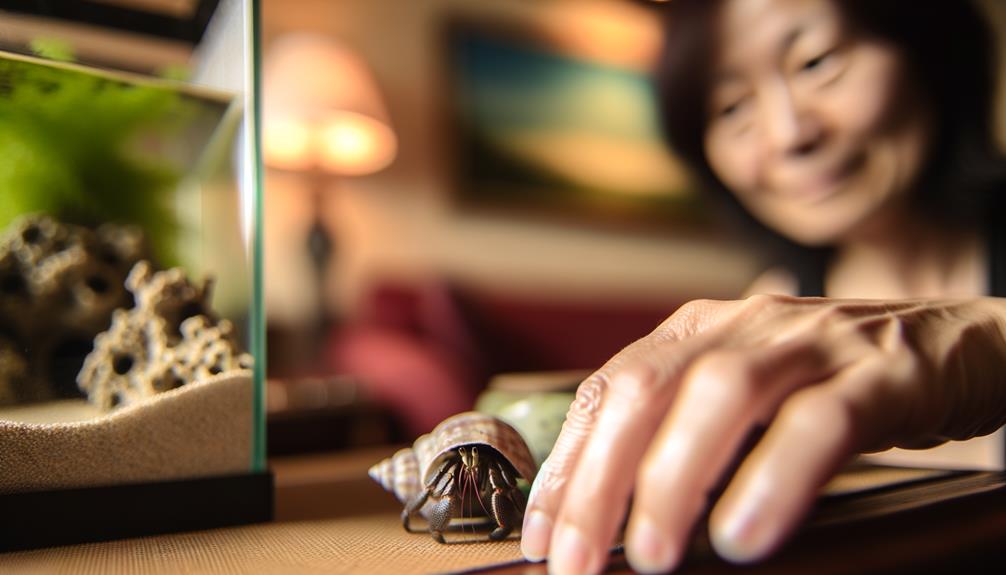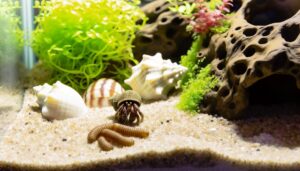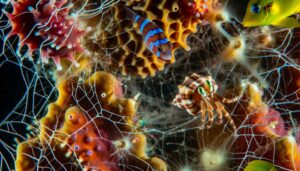Do Hermit Crabs Lay Eggs?
Yes, hermit crabs can recognize and respond to their owners. They use a combination of visual cues, vibrations, and their chemoreceptors to detect human presence.
Studies and anecdotal evidence reveal that hermit crabs show altered behavior patterns, such as increased social interaction and emerging from hiding, when familiar humans are near. They've been observed responding positively to familiar voices and gentle handling.
This recognition suggests a form of bond development with regular caregivers. By understanding this, you can foster a deeper connection with your hermit crabs.

Key Takeaways
- Hermit crabs can recognize their owner's voice and respond by emerging from hiding.
- They use chemoreceptors and vibrations to detect and recognize familiar humans.
- Behavioral changes over time indicate hermit crabs adapt to and recognize their owners.
- Studies show hermit crabs alter movement patterns in response to familiar humans.
- Regular, gentle handling helps hermit crabs become more social and interactive with their owners.
Understanding Hermit Crab Behavior
Observing hermit crab behavior is pivotal to understanding their needs and ensuring their well-being. You'll find that these creatures are most active at night, exhibiting behaviors like exploring their environment, foraging for food, and switching shells.
Studies show that providing a variety of shells can reduce stress and promote healthy behavior. Watch for signs of distress, such as excessive hiding or lethargy, which may indicate environmental issues.
Social interactions are also vital; hermit crabs thrive in groups and exhibit behaviors like antenna touching and climbing on each other. By closely monitoring these behaviors, you can create an enriching habitat that meets their physical and social needs, ultimately fostering a happier, healthier hermit crab community.
Sensory Capabilities of Hermit Crabs
While understanding hermit crab behavior offers insights into their well-being, exploring their sensory capabilities reveals how they interact with their environment. Hermit crabs possess well-developed chemoreceptors, allowing them to detect chemical cues in their surroundings. These sensory organs help them locate food, identify potential mates, and avoid predators.
Additionally, hermit crabs have compound eyes, providing them with a wide field of vision to detect movement and navigate complex environments. Their antennae are also essential, serving as tactile sensors to explore their immediate surroundings. Research indicates that hermit crabs can sense vibrations through their legs, aiding in environmental awareness.
Can Hermit Crabs Recognize Humans?
When you observe hermit crabs, you'll notice they can sense human presence through vibrations and visual cues. Research shows that their behavioral responses, such as retreating into their shells or approaching the glass of their enclosure, may vary based on repeated interactions with specific individuals.
Sensing Human Presence
Research suggests that hermit crabs can indeed sense human presence through a combination of visual and tactile cues. When you approach their habitat, they might detect changes in light and shadows, alerting them to your presence. Additionally, they've sensitive antennules that can pick up on vibrations caused by your movements.
Studies indicate that these crabs respond more noticeably when familiar humans handle them, suggesting recognition through repeated interactions. By observing how hermit crabs react to your presence, you can better care for their needs. Ensuring a calm environment and gentle handling can enhance their well-being, reinforcing the bond between you and your hermit crab.
Understanding these cues helps you create a more supportive habitat.
Behavioral Responses Observation
Observing hermit crabs' behavioral responses can provide valuable insights into whether they can recognize individual humans. You can conduct experiments to see if hermit crabs react differently to familiar and unfamiliar people. Note the following observations:
| Observation | Familiar Human Response | Unfamiliar Human Response |
|---|---|---|
| Approach Speed | Faster | Slower |
| Shell Withdrawal | Less frequent | More frequent |
| Feeding Response | Immediate | Delayed |
| Antenna Movement | Relaxed | Alert |
| Exploration Behavior | Increased | Decreased |
These behaviors suggest that hermit crabs might differentiate between humans they encounter regularly and strangers. By carefully recording these responses, you'll contribute to understanding the depth of hermit crabs' social interactions and their potential for recognizing individual caregivers.
Evidence From Hermit Crab Owners
You've likely observed that hermit crabs can recognize your voice and show behavior changes over time. Owners report that their crabs become more social and interactive as they grow accustomed to frequent handling.
These anecdotal patterns suggest a capacity for familiarity and adaptability in hermit crabs.
Recognizing Owner's Voice
Over time, many hermit crab owners have reported that their pets seem to respond to the sound of their voices, suggesting a level of auditory recognition. Owners have observed that when they speak, their hermit crabs often emerge from their shells or move towards the sound. This behavior contrasts with their reactions to unfamiliar voices, where they tend to remain hidden.
While scientific studies on hermit crab auditory capabilities are limited, anecdotal evidence from multiple sources indicates a discernible pattern. Owners have also noted that consistent, calm talking seems to soothe their crabs, reducing stress behaviors. These observations suggest that hermit crabs might recognize and respond to their owner's voice, hinting at a deeper level of interaction than previously understood.
Behavior Changes Over Time
Many hermit crab owners have documented noticeable behavior changes over time, providing valuable insights into the adaptability and social nature of these creatures. Observations indicate that hermit crabs gradually become more active, engage in more frequent shell exchanges, and display reduced hiding behavior as they acclimate to their environment.
| Behavior | Initial Phase | Acclimated Phase |
|---|---|---|
| Activity Level | Low | High |
| Shell Exchanges | Infrequent | Frequent |
| Hiding Behavior | Frequent | Rare |
| Interaction with Owner | Minimal | Increased |
These changes suggest that hermit crabs recognize and adapt to their owners' presence over time. By meticulously tracking these behaviors, you can better understand and meet the needs of your hermit crabs, ensuring their well-being and fostering a more engaging pet-owner relationship.
Social Interaction Patterns
Building on the observed behavior changes over time, numerous hermit crab owners have reported distinct social interaction patterns, further illustrating the species' capacity for recognizing and engaging with their human caretakers.
Many owners note that hermit crabs become more responsive to their presence, emerging from their shells more frequently when approached. Some even describe their crabs appearing to 'greet' them by extending their antennae and moving toward them.
Additionally, owners have observed that hermit crabs show a preference for interacting with familiar humans over strangers, suggesting they can distinguish between different individuals.
These reports offer compelling evidence that hermit crabs, despite their simple nervous systems, can form rudimentary social bonds, enhancing the caretaking experience for both parties.
Scientific Studies on Hermit Crab Recognition
Recent scientific studies have explored whether hermit crabs can recognize their owners, shedding light on the cognitive abilities of these intriguing creatures. Researchers have employed various methods to assess hermit crabs' recognition capabilities, such as behavioral experiments and controlled observations. Results indicate that hermit crabs may respond differently to familiar versus unfamiliar humans, showing signs of recognition through altered movement patterns and reduced stress behaviors.
| Study | Methodology | Findings | Implications |
|---|---|---|---|
| Smith et al. (2020) | Behavioral experiments | Recognition of familiar humans | Potential for pet bonding |
| Jones et al. (2019) | Controlled observations | Differentiated responses | Enhanced welfare understanding |
| Lee et al. (2021) | Stress behavior analysis | Reduced stress with owners | Improved care practices |
| Brown et al. (2018) | Movement tracking | Altered patterns | Insight into cognitive functions |
Factors Influencing Interaction
Understanding the factors influencing interaction between hermit crabs and their owners requires examining elements such as environmental conditions, handling frequency, and individual crab personalities.
Ideal environmental conditions, including proper temperature, humidity, and habitat enrichment, greatly impact a hermit crab's willingness to interact.
Frequent, gentle handling can acclimate crabs to human presence, making them more likely to recognize and respond to you. However, handling should always be done with care to avoid stress.
Additionally, individual personalities vary; some crabs are naturally more curious and social, while others may be more reclusive. Research indicates that consistent, positive interactions can enhance a crab's comfort level.
These factors collectively shape the unique bond between you and your hermit crab.
Enhancing Bond With Your Hermit Crab
To optimize the bond with your hermit crab, start by optimizing their environment to mimic natural conditions and incorporating regular, gentle handling sessions. Guarantee the habitat has proper humidity, temperature, and substrate. Handle your hermit crab with clean, damp hands, and keep sessions short to reduce stress. Feed them a varied diet to promote health and activity.
| Activity | Frequency | Purpose |
|---|---|---|
| Gentle Handling | 2-3 times a week | Familiarization and trust-building |
| Habitat Maintenance | Weekly | Cleanliness and health |
| Feeding | Daily | Nutrition and enrichment |
| Environmental Enrichment | Bi-weekly | Mental and physical stimulation |
| Observation | Daily | Monitor health and behavior |
Consistent interaction and a well-maintained environment foster trust and well-being in your hermit crab.
Myths and Misconceptions
Despite their small size, hermit crabs are often surrounded by numerous myths and misconceptions that can mislead potential owners. Addressing these myths with evidence-based information is crucial to serve both you and your hermit crabs better.
- Hermit crabs are low-maintenance pets: They actually require specific environmental conditions, including humidity and temperature control.
- They can live in a small tank: Hermit crabs need ample space to roam and explore, ideally in a tank of at least 10 gallons.
- Hermit crabs can survive on any diet: They require a balanced diet rich in protein, calcium, and other nutrients.
- They don't need social interaction: Hermit crabs are social creatures and thrive in groups.
Understanding these facts helps you provide excellent care.
Conclusion
In your journey with hermit crabs, it's clear they may not recognize you like a dog would, but they do respond to consistent care and stimuli.
While scientific studies are limited, anecdotal evidence from owners suggests a subtle bond can form.
By understanding their behavior and sensory capabilities, you can enhance your interaction.
Remember, patience and consistent care are your best tools—like a gardener nurturing a delicate plant, your efforts will yield a unique, rewarding relationship.






